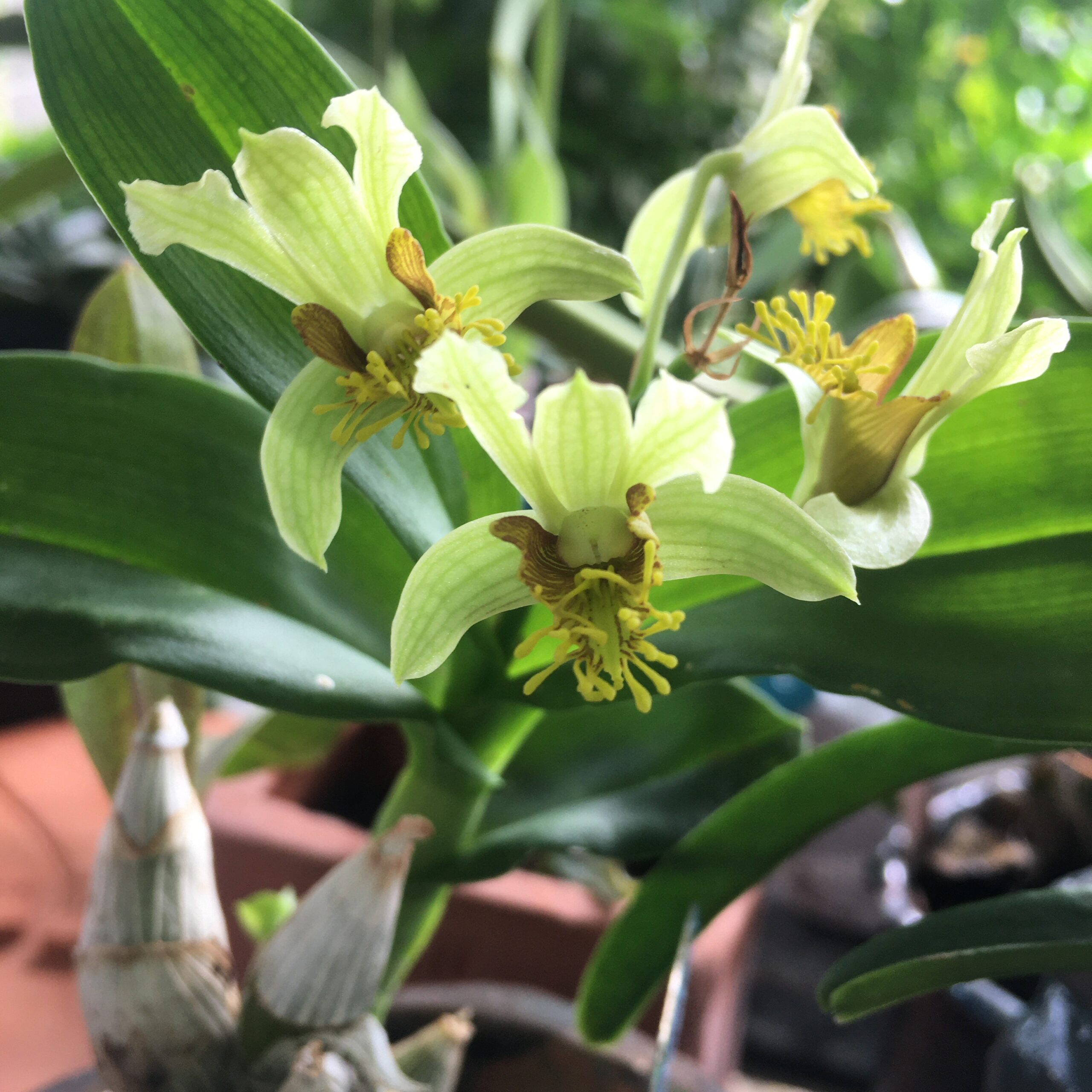Rick Lockwood’s groundbreaking 2013 study on orchid nutrition sheds light on the misconceptions surrounding potassium levels in orchid care. This research prompts many orchid enthusiasts to reconsider their fertilisation methods.
The Problem
Lockwood faced several challenges in growing orchids, including stunted growth, diseases, pests, poor root development, and plant death. His initial fertilisation regime followed the conventional NPK (Nitrogen, Phosphorus, Potassium) balance with added micronutrients, which did not resolve these issues.
Key Findings
Lockwood’s research revealed crucial insights about orchid nutrition:
- Natural Habitat: Tropical orchids thrive in environments with low potassium levels relative to calcium and magnesium. Potassium is notably scarce in limestone lithophytic environments.
- Bioaccumulation: Orchids show higher potassium levels in plant tissues than those available from natural sources, indicating bioaccumulation and recycling.
- Water Sources: Natural water sources such as streams and rainwater have low potassium levels. Wild orchids rarely encounter high potassium concentrations.
- Nutrient Uptake: Excessive potassium can hinder the absorption of calcium and magnesium, which in turn reduces phosphate uptake.
- Growth and Disease: Imbalanced potassium/calcium/magnesium ratios can lead to stunted growth and increased disease susceptibility.
- Fertiliser Suitability: High-potassium fertilisers are more suitable for fast-growing annuals, not for slow-growing perennials like orchids.
- Nutrient Reabsorption: Epiphytic orchids reabsorb about half of their potassium during leaf senescence.
- Ants’ Role: Ants may contribute to the nutrition of some epiphytic orchids.
- Energy Requirement: Orchids are efficient at potassium uptake and sequestration, but this process requires significant energy.
A New Fertilising Strategy
Lockwood developed a new fertilising approach based on nutrient ratios found in wild orchids compared to commercial fertilisers:
Wild Orchid Nutrients: Wild orchids generally have lower potassium levels relative to calcium and magnesium.
New Fertiliser Mix: He created a fertiliser mix by reducing the standard MSU fertiliser and adding calcium nitrate and magnesium sulphate. The total nitrogen input was reduced to 30-50 ppm, occasionally up to 100 ppm on warm sunny days. Between fertilisations, irrigation water was supplemented with calcium and magnesium.
Introducing “K-Lite”
Collaborating with other growers, Lockwood formulated “K-Lite,” a nutrient mix with a ratio of 12-1-1-10-3 (N-P-K-Ca-Mg) at 100 ppm nitrogen in RO water. Lockwood personally used K-Lite at about 50 ppm nitrogen in soft water, resulting in a ratio of approximately 6-0.5-0.5-6-2.
For species from calcareous regions, he added aragonite aquarium sand to provide more calcium and maintain pH balance. Baskets were seeded with local live mosses to sustain suitable pH levels in the root zone over multiple growing seasons.
Growing Media and Potting Mix
Lockwood’s findings on potting substrates emphasised the importance of cation exchange capacity:
Coconut Husk Chips (CHC): Highest cation exchange capacity, followed by fir bark and moss.
Potassium Concentrations: Keeping potassium levels lower than calcium and magnesium helps prevent “souring” of organic potting mixes.
Calcium Additions: Adding readily available calcium or dolomite extends the effective life of potting mixes.
Orchiata Bark: The dolomitic lime composting process used for Orchiata Bark contributes to its success as a potting material.
Observations Over Two Years
Although two years is a short timeframe, Lockwood observed significant improvements after adopting the new fertilising regime:
- Larger, stiffer, and shinier leaves
- Reduced issues with Erwinia, mealybugs, and scale
- Improved recovery in declining plants
- Better transition of seedlings from compots to individual pots
- Four plants received AOS quality awards
- Ant-favoured species like Gongoras and Coryanthes may need additional potassium during rapid growth periods.
Conclusion
Lockwood’s study challenges traditional orchid fertilisation methods, advocating a more natural, ecology-based approach. Key takeaways include:
- Wild orchids experience lower potassium levels relative to calcium and magnesium compared to standard fertilisers.
- High potassium impedes calcium and magnesium uptake, essential for plant health.
- The “K-Lite” formula reduces potassium while increasing calcium and magnesium.
- Lower overall fertiliser concentration and frequency can be beneficial.
- Potting media affects nutrient availability; good cation exchange capacity and calcium/dolomite amendments help maintain nutrient balance.
- Initial results show improved plant health, stronger growth, and reduced pest and disease issues.
- Species-specific needs may vary, particularly during rapid growth periods.
Continued long-term observation and experimentation are essential for refining these practices. This approach represents a significant shift towards an ecology-based nutritional strategy for orchids.
Practical Tips for Home Gardeners
How can you increase your supplementation of magnesium and calcium to your orchid plants?
Commercially Available Options
Organic Orchid Fertiliser: Look for pre-made organic liquid fertilisers specifically formulated for orchids, which often include a balanced ratio of calcium and magnesium.
Cal-Mag Supplements: Some brands offer separate calcium and magnesium supplements that you can mix based on your needs.
DIY Options
Eggshell Tea (Calcium): Boil a handful of eggshells in a gallon of water for 30 minutes. Let it cool, strain, and dilute before applying (around 1/2 strength).
Magnesium Sulphate (Epsom Salts): Dissolve 1 teaspoon of Epsom salts per gallon of rainwater or RO water.
Mixing and Application:
Ratio: Aim for a 2:1 calcium to magnesium ratio. Adjust based on your specific needs and water analysis.
Implementation: Start with a weak solution and gradually increase concentration while monitoring plant response. Apply weekly, alternating with regular (low-potassium) fertiliser, and use calcium and magnesium-enriched water for regular irrigation.
Water Quality and Holistic Approach
- Test your water to understand its baseline calcium and magnesium levels. Adjust supplementation as necessary.
- Maintain a well-draining potting mix, appropriate watering practices, and a balanced fertilising regime to support healthy orchids. Why not trying using coconut husks or fibre as your preferred medium
Alternatives for Calcium
- Calcitic Lime Water: Mix a teaspoon of calcitic lime to a gallon of rainwater or RO water. Let it sit for 24 hours, filter, and dilute before applying.
- Crushed Oyster Shells: Add to potting mix for slow calcium release.
Final Note
Lockwood’s article, though not peer-reviewed, offers valuable insights. As a scientist, Lockwood likely applied rigorous methods to his observations. However, readers should be aware that this work hasn’t undergone formal peer review typical of academic publications.
References
Lockwood, R. (2013). “Orchid Nutrition: Debunking the Potassium Myth.” Orchids Magazine.
For more information, visit our website or read our detailed articles on using coconut fibre and Seasol for orchid care.
This article was referenced from an article in the American Orchid Society ‘Orchids’ magazine



One thought on “Orchid Nutrition: the Potassium Myth”